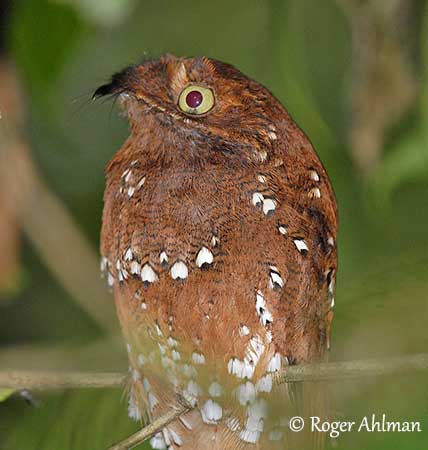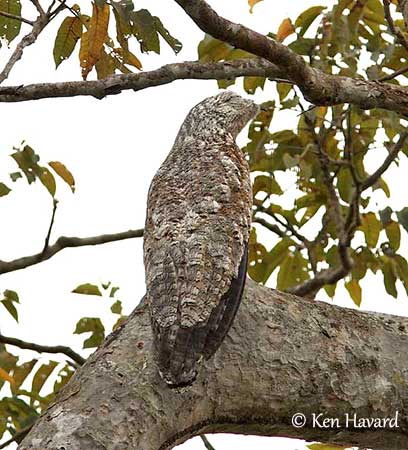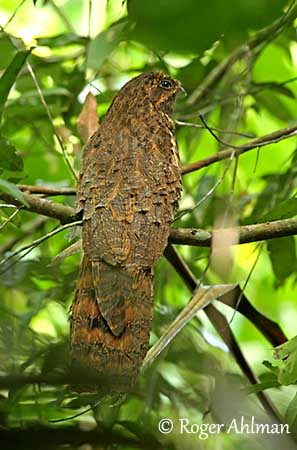
Text by Nicole Bouglouan
Photographers:
Roger Ahlman
Pbase Galleries Peru and Ecuador
Marc Chrétien
MURINUS
Jean Michel Fenerole
Photos d’Oiseaux du monde
Ken Havard
My Bird Gallery & Flickr gallery 1 & Flickr gallery 2
Patrick Ingremeau
TAMANDUA
Tom Merigan
Tom Merigan’s Photo Galleries
Philippe et Aline Wolfer
GALERIE
Sources:
HANDBOOK OF THE BIRDS OF THE WORLD Vol 5 by Josep del Hoyo-Andrew Elliott-Jordi Sargatal - Lynx Edicions - ISBN: 8487334253
NIGHTJARS - A Guide to Nightjars and Related Nightbirds – Nigel Cleere and Dave Nurney - Yale University Press - First Edition (August 11, 1998) - ISBN 10: 0300074573 / ISBN 13: 9780300074574
A GUIDE TO THE BIRDS OF MEXICO AND NORTHERN CENTRAL AMERICA by Steve N. G. Howell, Sophie Webb - Oxford University Press - ISBN: 0198540124
A GUIDE TO THE BIRDS OF COLOMBIA by Steven L. Hilty and William L. Brown - Princeton University Press – ISBN 069108372X
BirdLife International (BirdLife International)
Wikipedia, the free encyclopaedia
Neotropical Birds – Cornell Lab of Ornithology
Rediscovery of Nyctibius leucopterus (White-winged Potoo) in the Atlantic Forest of Brazil
SORA Searchable Ornithological Research Archive (Blair O. Wolf)
Alejandro Solano-Ugalde Boletín SAO Vol. 20
Natural history of Rufous Potoo in Ecuador
FAMILY NYCTIBIIDAE
Caprimulgiformes Order
Potoos – Genus Nyctibius
Potoos and their mysteriousness have always fascinated men. Their typical cryptic plumage and pose with sleeked feathers and bill pointing upright when they are disturbed are the origin of the name “mira para el cielo” given in some parts of Colombia. This name means “look at the sky” and describes the peculiar appearance used by these birds to become invisible while roosting during the day, so similar to the tree-bark.
Another name from Brazil, “mãe-da-lua” meaning “mother of the moon” is inspired by their haunting song heard at night, and especially on moonlit nights. But the melancholy song is also considered a sign of bad luck or impending death, and sometimes attributed to other nocturnal animals.
In addition, potoo feathers, because of their decorative appearance, are occasionally used by Amazonian Indians as ornaments, and in Brazil, the feathers of several potoo species are included in necklaces.

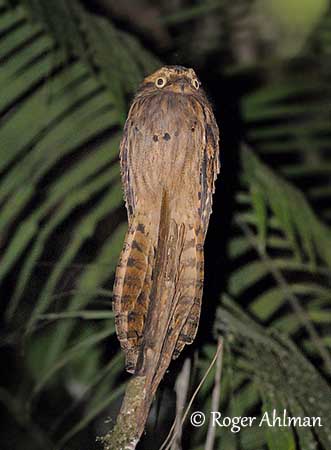
Potoos are endemic to the Neotropics, and are primarily found in the Amazonian lowlands. They differ from other families by the “toothed” bill with short culmen and wide gape, and the tooth-like projection positioned on each side of the tip of the bill. They lack the rictal bristles, although some thin bristles occur in the loral area between the eye and the nostril. Their very large eyes adapted to life at night, reflect a strong red or orange glow in a beam of light. Another peculiar feature is the upper eyelid which shows two or three small folds along the edge, creating notches or slits, and allows the bird to detect potential movement or danger while roosting, although having the eyes closed. The short legs and the small, weak feet are only used for perching on branches, and the fleshy pads on the underside of the toes are probably an adaptation to this behaviour.
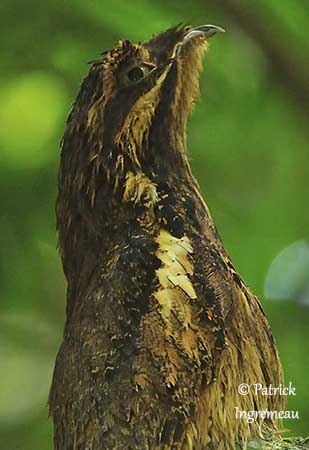
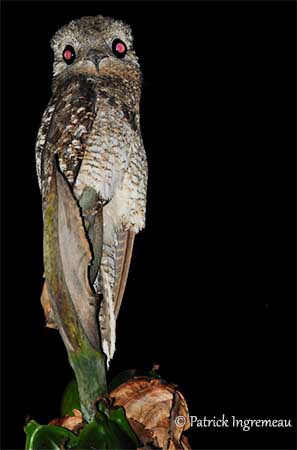
Potoos have large heads (but tiny brain!), long wings and tail compared to their small body and short legs. The plumage pattern is complex but very cryptic, usually brown and grey with darker barring, streaking and spotting overall. Underparts are usually paler than upperparts, with pale chin and throat. Some species show variable whitish wing-patch formed by the pale coverts, like in the White-winged Potoo. Most potoos have dark blotches on the breast, like an indistinct breast band.
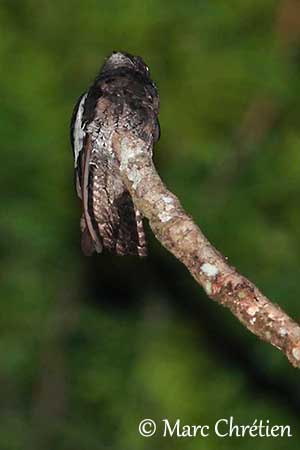
We can find some exceptions like the Great Potoo, the palest and most variable species with some birds showing nearly white plumage. Another exception, the Rufous Potoo, has almost uniform bright rufous plumage with black-bordered white spots, making it very similar to the Oilbird.
Male and female are similar in plumage. The juvenile is usually much paler than adults with some pure white young birds. However, the young Rufous Potoo is darker and browner than adults.
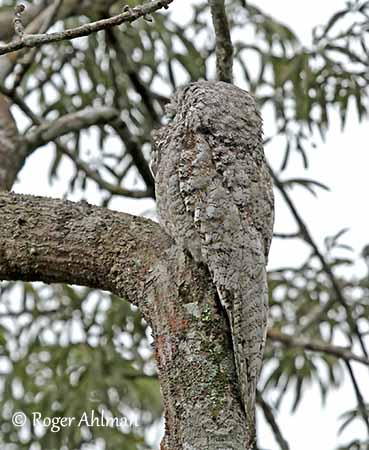
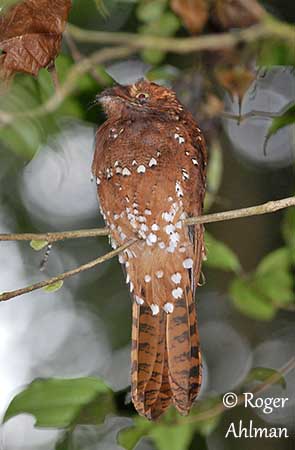
As nocturnal species, the potoos roost during the day, perched in trees on horizontal branches or more often at top of broken stub in exposed places or in the canopy. The bird is alone, perched in upright stance with its eyes closed, the head is tucked into the shoulders and the body feathers are loose. The cryptic plumage looks like the tree bark and is similar to a dead stump or branch.
However, when disturbed, the potoo assumes a “freezing” posture with elongated body, sleeked feathers, upstretched neck and bill pointing skywards, accentuating its resemblance with a broken dead branch. Usually, there is no movement detected by the intruder as the transition from roosting to freezing posture is slow and gradual. The potoo does not move during the day, except to stretch its wings or scratch its head.
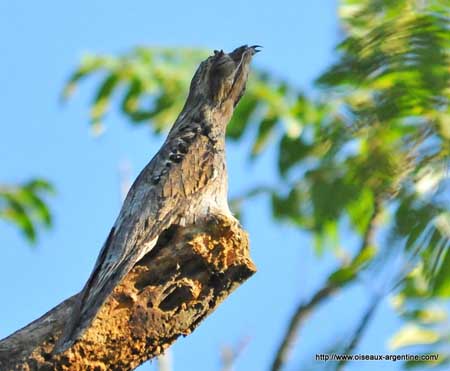
But it comes back to life at night. It hunts from a perch, searching for preys while turning the head rapidly from side to side or following the movement of some flying insect. It hunts by sallying from the perch. It catches the prey and returns to the same or another perch between two sallies. But it may also pursue the prey on the wing, being surprisingly acrobatic even in dense forest. The Long-tailed Potoo chases flying termites in the understorey by turning abruptly or suddenly changing directions while flying. The diet includes insects such as beetles, cicadas, mantids, moths and flying termites. The prey is engulfed whole while flying.
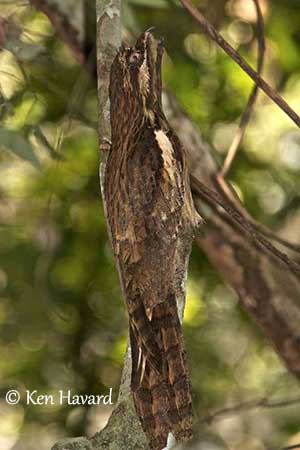
The flight is silent, due to broad, fluffy feathers with aftershafts. The wingbeats are stiff and buoyant like in huge butterflies. The potoos glide on flat wings with tips slightly downwards. In direct flight or glides the tail is closed, but when they pursue a prey or for landing, the tail is spread wide open.
All potoos are forest birds and are found in dense humid forest, but some of them may occur in drier forest or in low vegetation with scattered patches of trees. The lowland Amazonian species are found in terra firme woods (never flooded), while Common Potoo and Great Potoo can be found in seasonally flooded várzea. The Northern Potoo occurs in both humid and dry forests and plantations. But the Andean Potoo is the only one which occurs in humid montane cloud forests at high elevation, between 1800 and at least 2800 metres.
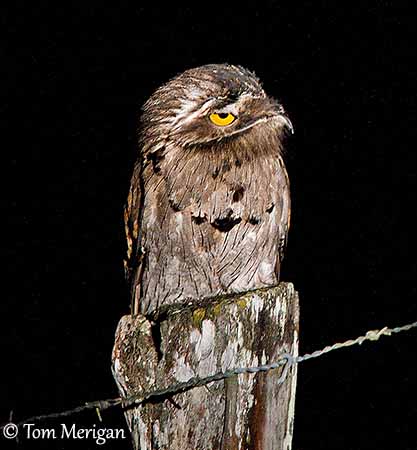
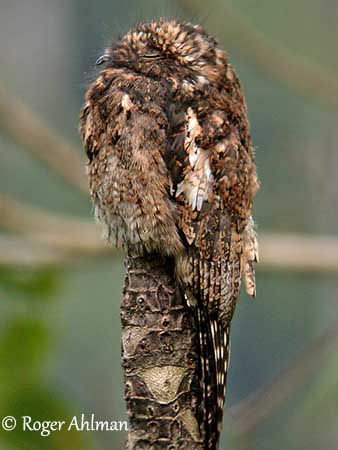
They often occur in the canopy, but some of them such as the Common Potoo, the Great Potoo and the Northern Potoo are regularly found in open habitats at night. The Rufous Potoo is mostly found in tall rainforest, while the Long-tailed Potoo is often seen at edges and in open forest. The White-winged Potoo remains in the canopy of tall forests.
Generally, they can be flexible in their habitat selection, but with some preferred habitat types including forest.
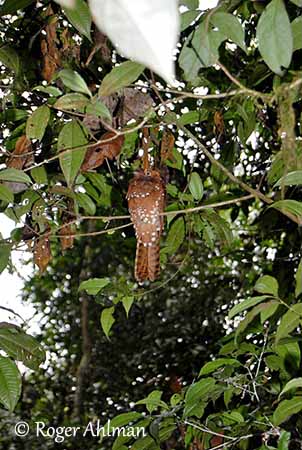
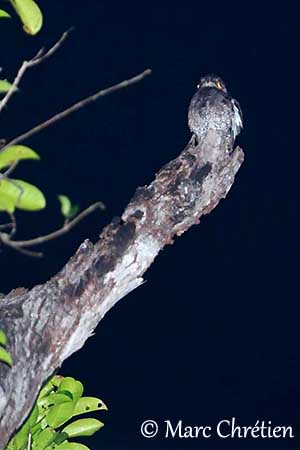
Pair members are rarely seen together even at the nest-site. But at night, two birds, probably a pair, can sometimes be heard singing in the same area. They sing at night, and mainly on moonlit nights. Both males and females sing, but the female’s song is weaker. The members of a pair use some short notes as contact calls. Distinctive vocalizations are associated with displays, alarm and nesting period.
Potoos are known for their haunting, plaintive songs given at night from perches. These songs are used as territorial advertisement and the species have distinct vocal types, one in N Central America, and the other in S Central America and throughout South America. Their vocalizations can help to identify the species.
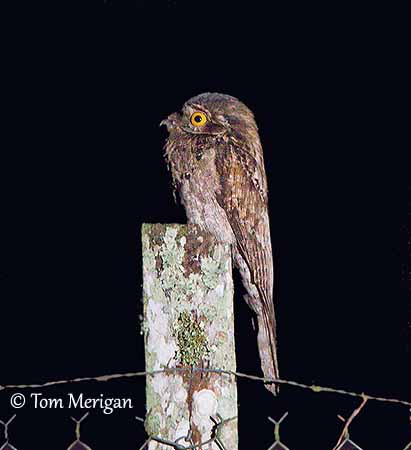
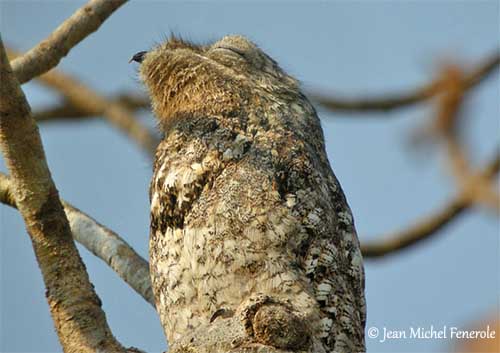
Little is known about the breeding behaviour of Nyctibiidae because they are difficult to find. They are monogamous and both adults share all the nesting duties. They probably have long-term pair-bonds, as they maintain territories for long time, usually all year round.
From an observation, a female was uttering unusual vocalizations involving the arrival of the male and the copulation. But currently, we do not know how the nests-site is chosen.
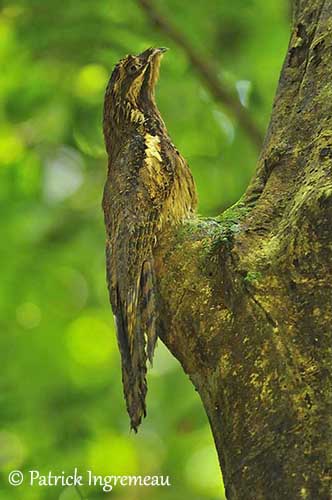
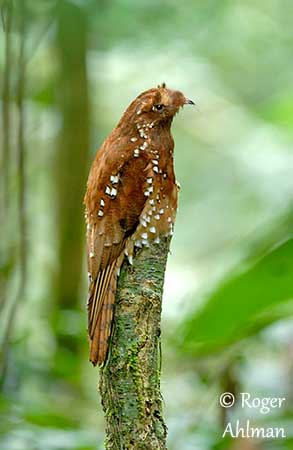
On the nest
On the nest
The potoos do not build a nest. They use a natural depression on a branch in tree, often a scar left by a fallen broken branch, or at top of broken stub. Only a hollow without additional nest material is used for the egg.
The female lays a single egg in this depression. It is white with dark markings mainly near the broad end. Both adults incubate during at least one month, and the incubating parent perches at the edge of the hollow like for resting. The egg disappears completely under the feathers of the adult’s belly. Later, the chick is in the same position, both adult and chick facing in the same direction. The chick is visible only when it is fairly large, but it remains against the adult’s feathers.
Both parents take turns during the incubation, usually the male by day and the female at night. The chick is fed a few times during the night, usually after dusk and before dawn. It is fed by regurgitation at nest.
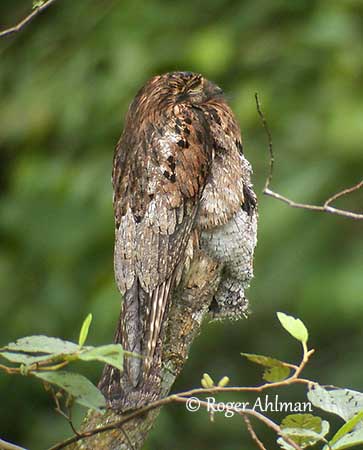
With chick under belly's feathers
Activity and vocalizations are limited at nest to avoid predation. In defence and as intimidation display, the adult uses its cryptic plumage, but it also opens its huge eyes and suddenly moves with snapping open mouth. During the day, the adults may perform distraction displays such as “broken wing display” or even falling to the ground like a dead piece of branch.
The begging calls increase as the chick is growing, uttering single, buzzy notes. If threatened, the growing chick may adopt the freezing posture of the adults and also uses the same type of defence.
One parent and its nestling may perform a gentle rocking motion at the nest. Before fledging, the chick makes some wingbeats at night. It will perch near the nest for some days more after fledging. The fledging period may last two months after hatching.
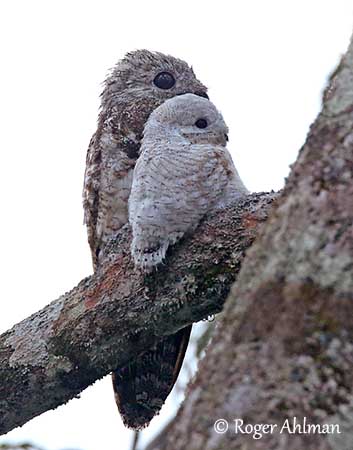
With chick
The potoos are sedentary in their range. They maintain territories all year round and are often seen on the same perches year after year. They have a Neotropical distribution and occur from Mexico to Argentina, with five species in the Amazon Basin. They are found in both Central and South America except in Chile. In addition, the Northern Potoo occurs in Jamaica, Hispaniola and Tobago.
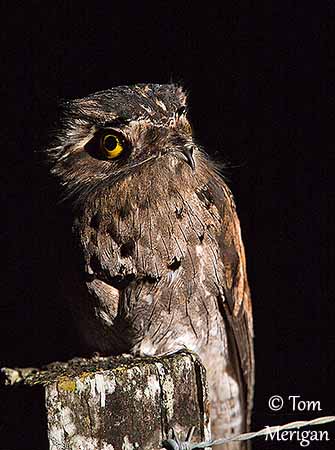
All the seven potoo species are evaluated as Least Concern. They can be locally common in their range but as they are inconspicuous, they are almost invisible and difficult to control.
All species are threatened by habitat loss through intense deforestation, especially in the Atlantic Forest in E Brazil. But habitat destruction in the Amazon continues too, and in spite of huge remaining expanse of primary forest, the situation will become critical in a few years.
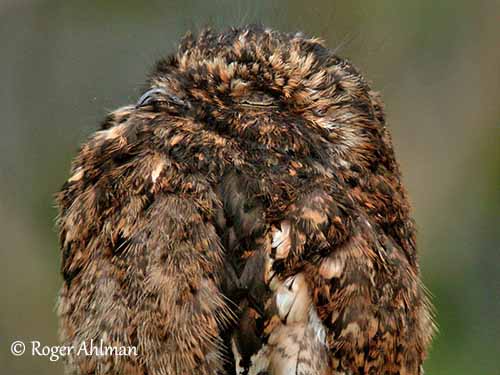
Potoos naturally have low population densities and they need protected areas of suitable habitat to maintain these populations. Forest management with conservation of snags for roosting, foraging and nesting would be necessary to protect these birds included in the Nyctibiidae, one of the world’s least known bird families.
